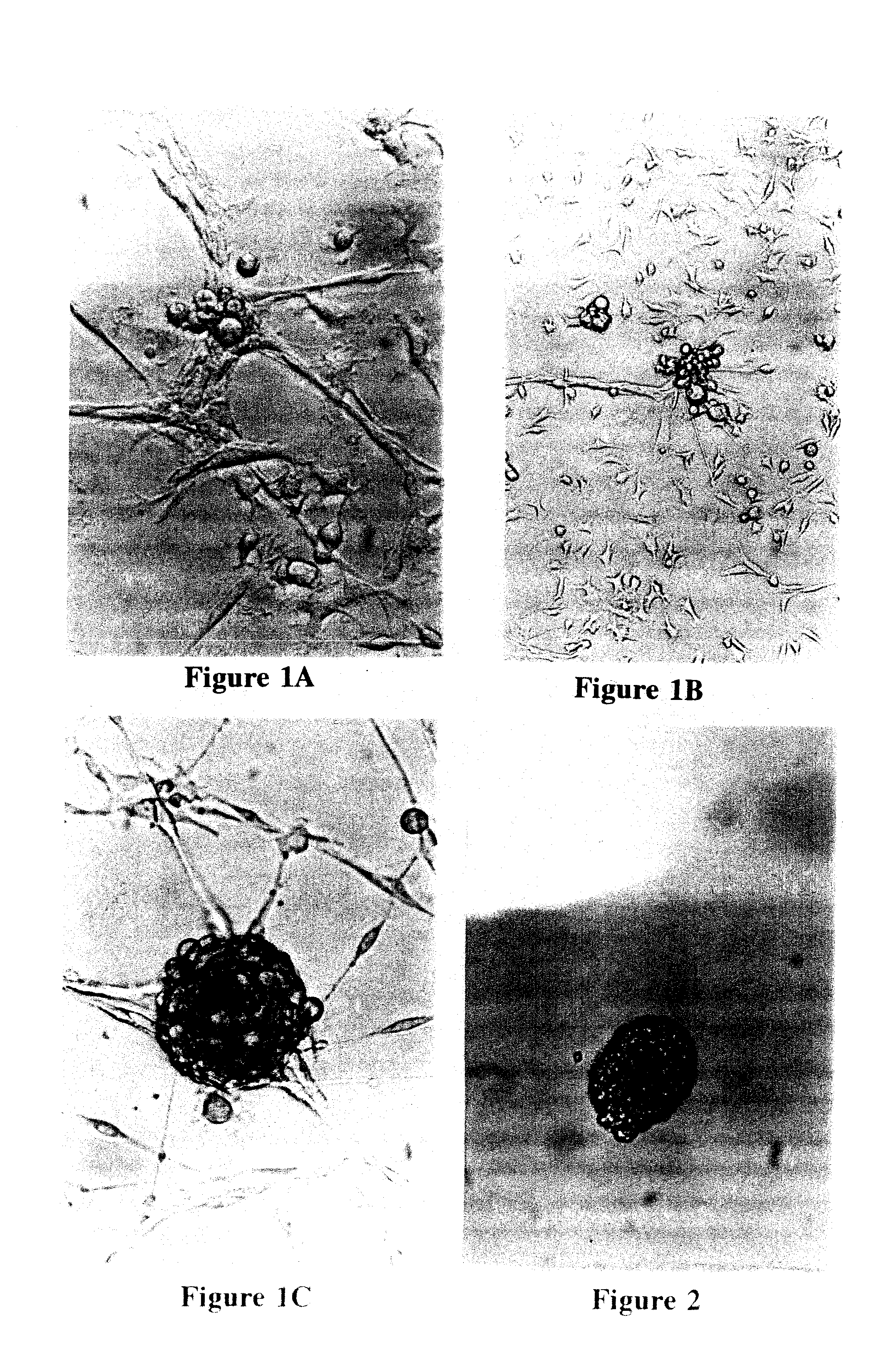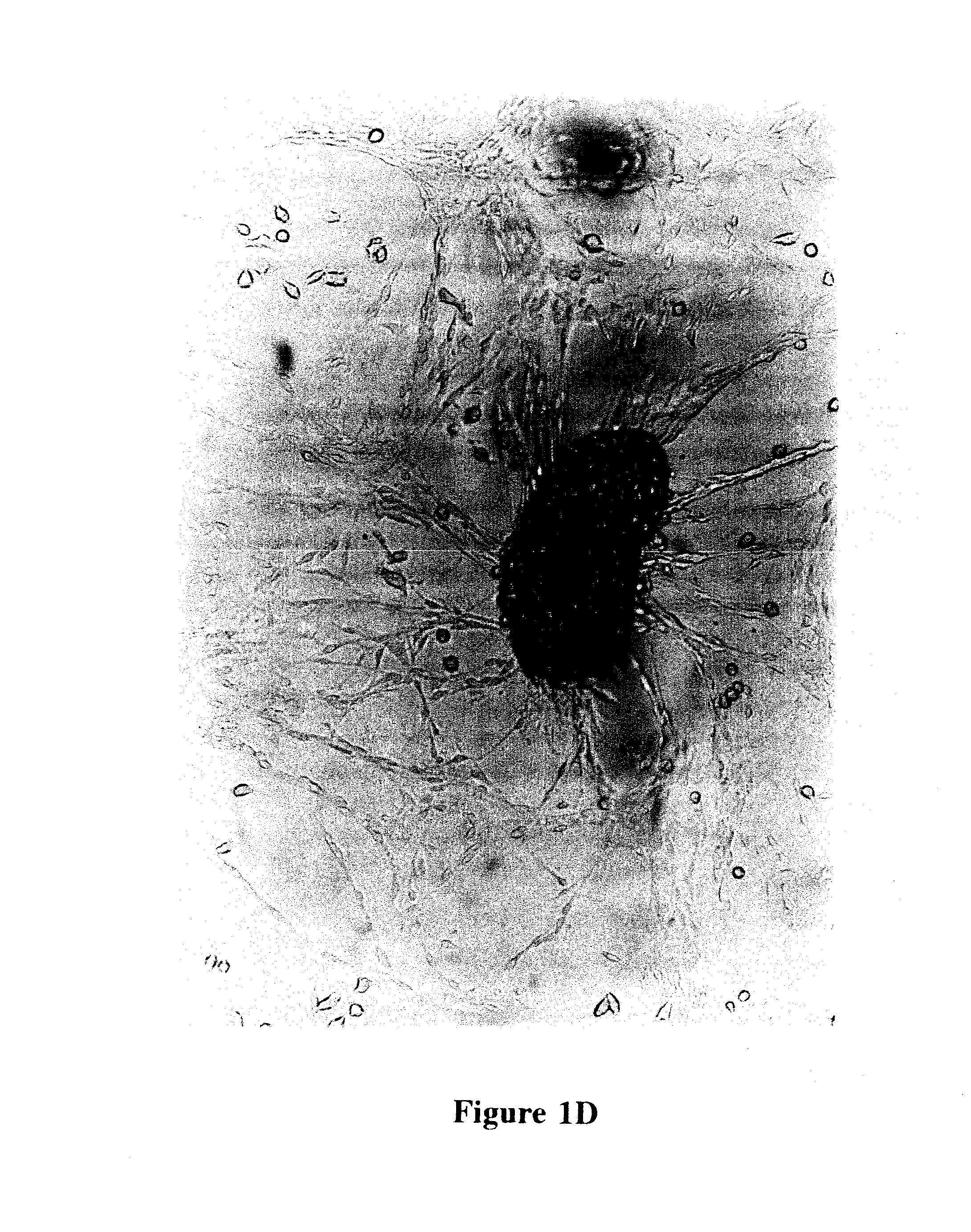Reversal of insulin-dependent diabetes by islet-producing stem cells, islet progenitor cells and islet-like structures
a technology of stem cells and islets, applied in the field of ipscs, can solve the problems of affecting the development of diabetes, so as to improve the understanding of the mechanism of diabetes, control or eliminate patients, and facilitate the effect of genetic engineering of ipscs
- Summary
- Abstract
- Description
- Claims
- Application Information
AI Technical Summary
Benefits of technology
Problems solved by technology
Method used
Image
Examples
example 1
Culturing of Functional Islets of Langerhans
[0088]Single cell suspensions of islet cells were prepared from whole islets isolated from the pancreas of 19-20 week old prediabetic male NOD / UF mice, as detailed elsewhere (Shieh et al., 1993). Typically, about 25% of the male mice in a NOD colony will have overt IDD at this age and all will have severe insulitis. The islet cells were re-suspended in glucose depleted or glucose-free Click's EHAA medium (Peck and Bach, 1973; Peck and Click, 1973) supplemented with normal mouse serum (NMS) to 0.25%, plated in a 25 cm2 tissue culture flask, and incubated at 37 C in a 5% CO2 atmosphere. At this stage, two outcomes are possible: first, the islet-infiltrating cells may dominate, thus permitting the establishment of immune cell lines, or second, ductal epithelial cells (often referred to as stromal cells in these cultures) may dominate, thus allowing the growth of a nurse cell monolayer. Growth of ductal epithelial monolayers appeared to result...
example 2
Culturing of Human IdIs
[0092]For culturing human IdI cells, a procedure similar to that described in Example 1 was utilized. The procedure of the subject invention is particularly advantageous because it is not necessary to utilize fetal cells to initiate the cell culture. In a preferred embodiment, the human cells can be suspended in Click's EHAA medium (or the equivalent thereof) supplemented with normal human serum. Preferably, the concentration of normal human serum used in the medium is about 0.25%-1% in phases I and II, respectively, and 5% during subsequent phases. The cultures were left undisturbed with no re-feeding for several weeks (phase I). After about 4-5 weeks in culture, cell differentiation was initiated by re-feeding the cultures with Click's EHAA medium supplemented with normal human serum and glucose as described in Example 1. IdIs were subsequently collected and single cell suspensions prepared for further propagation as described in Example 1.
example 3
Implantation of In Vitro Grown Islet Cells
[0093]To test the efficacy of these in vitro generated IdIs to reverse the complications of IDD, approximately 150-200 foci plus some ductal epithelium grown in vitro according to the method of the subject invention from pancreatic tissue of NOD mice were dislodged from the tissue culture flask by reflux pipetting. The cells were then implanted beneath the kidney capsule of syngeneic diabetic NOD mice maintained by daily insulin injections. Implantation was accomplished by puncturing the kidney capsule with a hypodermic needle, threading a thin capillary tube through the puncture site into the kidney, and injecting the islet foci and epithelium directly into the cortex region. The capillary tube was carefully withdrawn and the puncture site cauterized. The surgical incision of each implanted mouse was clamped until the skin showed signs of healing. The implanted mice were maintained on insulin injections for 4 days at the full daily dosage, ...
PUM
| Property | Measurement | Unit |
|---|---|---|
| time | aaaaa | aaaaa |
| volume | aaaaa | aaaaa |
| volume | aaaaa | aaaaa |
Abstract
Description
Claims
Application Information
 Login to View More
Login to View More - R&D
- Intellectual Property
- Life Sciences
- Materials
- Tech Scout
- Unparalleled Data Quality
- Higher Quality Content
- 60% Fewer Hallucinations
Browse by: Latest US Patents, China's latest patents, Technical Efficacy Thesaurus, Application Domain, Technology Topic, Popular Technical Reports.
© 2025 PatSnap. All rights reserved.Legal|Privacy policy|Modern Slavery Act Transparency Statement|Sitemap|About US| Contact US: help@patsnap.com



